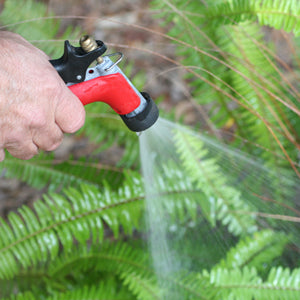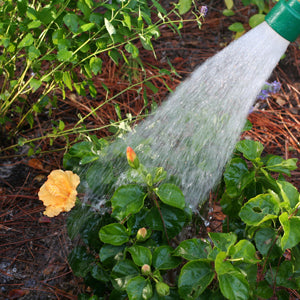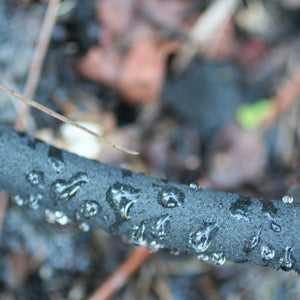Keeping your indoor and outdoor plants hydrated is essential if you want them to remain in top form. Keep these important tips in mind when it comes to watering your plants.
 Indoor Plants
Indoor Plants
Overwatering and under watering are probably the two main reasons why many houseplants suffer an early death. But, for most indoor plants, all you need to do is water them when the top inch of soil feels dry to the touch. Timing will vary depending on how dry the air is in your home, but in most cases giving your plants a once-a-week drink is sufficient. Keep in mind though, that some plants such as ferns prefer that their soil is just slightly moist at all times. And other plants such as cacti and succulents like life on the dry side and may only need a dash of water once every few weeks. If in doubt, read the plant label to know how much water your plant requires.
When you water indoor plants it’s also smart to “flush” the plant occasionally until you see excess moisture drip out the drainage holes. This will help prevent the build-up of excess salts in the soil. You may also have better luck with distilled water or rainwater if your tap water has a lot of dissolved elements in it from chlorination and fluoridation.
Adding a dilute solution of liquid fertilizer when you water is a great way to keep your plants fed. During the spring and summer months, add fertilizer to the water every 10 days to two weeks. Stop feeding your plants during the fall and winter.
If you have a drip tray beneath your pot to catch the excess water, empty the drip tray after a half hour or so if there's water sitting in it. Plants sitting in water in the drip tray too long can suffer suffocation of the roots, which can lead to root rot.
Tip: Make it easy with a self-watering system like Wick & Grow™.
Pots Without Holes
So what if you have a plant in a pot without drainage holes? Good news: You're not doomed to failure. But you do have to water a bit differently to ensure success. When there are no drainage holes, excess water can't escape -- and your plants can drown if water builds up. So it's important to provide enough water for your plant, but not let the soil become saturated. That may mean adding less moisture each time you water, and watering a little more often. You'll also want to use a moisture meter or probe the soil deeper with your finger periodically to see how moist it is at the bottom and prevent water from building up.
 Outdoor Plants
Outdoor Plants
Watering outdoor plants is a bit more complicated than indoor plants because those growing outdoors are subject to different weather conditions such as wind, rain, sun, and shade. Plus, outdoor soil conditions vary with heavy, clay-like soils holding water and sandy soils drying more quickly.
The key to success with outdoor plants is organic matter. Adding several inches of organic matter to the soil before you plant will improve fertility and help maintain consistent soil moisture. Material such as rotted manure, compost, or shredded leaves mixed into the top several inches of soil will act like a sponge, holding water in reserve until your plants need it.
Most outdoor plants, including vegetables and turf grasses, will thrive with one inch of moisture a week. Buy a rain gauge to keep track of how much water your plants are getting naturally. Then you can augment with additional water as needed. Watering outdoor plants can be done with a garden hose, sprinkler, irrigation system, soaker hose, or drip system.

Watering Methods
Garden Hose
Standing in your backyard holding a garden hose is the least efficient and effective way of watering your yard. No matter how patient you are you won’t be able to stay in place long enough to adequately soak the soil. And frequent shallow watering will encourage your plants to develop shallow root systems that dry out quickly. For containers or new plantings, use a watering wand to deliver a fine spray directly to the root zone of the plants.
Sprinklers
If you decide to use an oscillating sprinkler set a few empty coffee cans within its range so you can turn it off after it has delivered an inch of moisture. Keep in mind, though, that oscillating sprinklers can deliver water unevenly if the wind is blowing.
Irrigation systems
Automatic irrigation systems work well, particularly for lawns or large beds. Be sure to put your system on a timer so that it doesn’t overwater or erode parts of your landscape. Also, check your system regularly to be sure the heads are delivering water to your garden and not the neighbor’s driveway or sidewalk where the water is wasted.
 Soaker hoses
Soaker hoses
Soaker hoses “sweat” water through their surface, delivering a steady, slow source of moisture to your plants. Soaker hoses are ideal for vegetable gardens and perennial borders where they can be stretched along the garden rows. You can also bury them under the mulch to keep them out of sight (and reduce water waste to evaporation even more).
Drip Irrigation
Drip systems are a great way to water flower beds, containers, or vegetable gardens because they deliver water directly to the root zones of the plants so you won’t lose water to evaporation. Adding a timer to your drip system will also prevent it from keeping your garden too wet. Drip systems can also be designed to fit any garden space and configuration so they are extremely versatile.
When to Water
The best time to water outdoor plants is in the morning. This encourages them to absorb moisture before the mid-day sun heats things up. It also allows the leaves of your plants to dry out before nightfall, which helps minimize plant diseases. Some plants such as roses and tomatoes are particularly susceptible to wet foliage at night so if you are using an oscillating sprinkler or irrigation system program them to work early in the day.

















